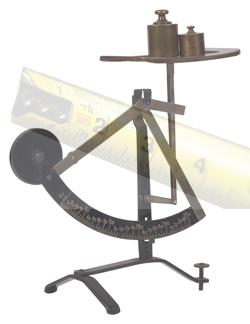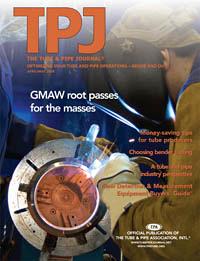- FMA
- The Fabricator
- FABTECH
- Canadian Metalworking
Categories
- Additive Manufacturing
- Aluminum Welding
- Arc Welding
- Assembly and Joining
- Automation and Robotics
- Bending and Forming
- Consumables
- Cutting and Weld Prep
- Electric Vehicles
- En Español
- Finishing
- Hydroforming
- Laser Cutting
- Laser Welding
- Machining
- Manufacturing Software
- Materials Handling
- Metals/Materials
- Oxyfuel Cutting
- Plasma Cutting
- Power Tools
- Punching and Other Holemaking
- Roll Forming
- Safety
- Sawing
- Shearing
- Shop Management
- Testing and Measuring
- Tube and Pipe Fabrication
- Tube and Pipe Production
- Waterjet Cutting
Industry Directory
Webcasts
Podcasts
FAB 40
Advertise
Subscribe
Account Login
Search
Buy it by the pound, sell it by the foot
Process optimization can help tube, pipe producers cut costs one foot at a time
- By Jeff Shelton
- April 15, 2008
- Article
- Tube and Pipe Production
With raw material and energy costs soaring and imported tube and pipe flooding the U.S., tube and pipe producers are facing increasing pressures to reduce costs to maintain profitability. While strategies for cutting costs or optimizing tube and pipe manufacturing processes abound, they usually fall into one of four categories:
- Maintenance costs for equipment
- Roll tooling costs (maintenance and replacement)
- Strip width
- Strip gauge
If you are a tube or pipe producer, you might turn your attention to strip widths and focus on how to best calculate a functional strip width. The old adage that explains how you process steel—"We buy it by the ton and sell it by the foot"—illustrates the need to squeeze as many feet of tube or pipe as possible out of a ton of steel. However, sacrificing strip thickness or width has its limits. Overall process yield and quality are the best places for your attention.
While any experienced mill operator knows that the tube-making process is somewhat forgiving and the opinions about various production methods are innumerable, one rule cannot be ignored: The more latitude you ask for from the process, the more cash the process will ask of you.
One example of cost reduction is preventive maintenance: You can initially reduce your maintenance costs by cutting back on preventive maintenance for the mill. However, you are likely to lose more than you gain when the mill stops at the worst possible time. This usually happens when you are already three days behind schedule, your customers are expecting deliveries, and you don't have the necessary repair parts in inventory.
A good preventive maintenance program helps to contain or limit potential costs because it optimizes mill uptime during available production hours. In other words, it helps you prevent costly downtime.
Roll maintenance is another area where you might be tempted to cut costs. However, running roll tooling past its serviceable life is akin to cutting back on mill maintenance. Postponing tooling reconditioning might appear to be a cost-saving strategy, but in the end you'll lose more profitability because of increased scrap rates and customer returns.
You might be able to increase output by reducing strip width, but this is not enough. A comprehensive process optimization program is necessary to reduce costs while maintaining product quality and consistency.
How Wide Is Wide Enough?
Strip width and gauge are popular focal points of cost reduction. You could reduce recommended strip widths without discernible adverse effects on the product. The key words here are recommended and discernible. While a strip width reduction of 0.030 inch would result in an average savings of 25 to 30 pounds per slit coil, a substantial reduction when projected over an entire year, you risk losing a significant portion of those savings in increased scrap and customer dissatisfaction.
The effects of wholesale strip width reduction on the tube-making process may be tolerable and even beneficial, but they could be catastrophic as well. It is imperative that you understand your baseline before considering adjustments.
Guidelines. While no one-size-fits-all method of strip width calculation exists, common industry knowledge is not the final authority either. Any reputable roll tooling supplier can recommend a suitable strip width for a given tooling set and gauge. This width is based on the roll design, mill length and design, and the forming method employed in the breakdown passes.
If this information is not available from your roll supplier, you can derive the minimum strip width from an existing ASTM bend allowance formula. The formula applied to the tube-making process can be rendered as:
Strip Width = (WD-t) * 3.1416 + (S+R)
Where:
WD = Diameter at the Weld Rolls
t = Wall Thickness
S = Weld Squeeze-out Allowance
R = Girth Reduction in Fin Rolls
This renders a basic strip width for most applications. Some applications, such as tubulars with low D/t (diameter-to-thickness) ratios or products made from high-yield-strength alloys, require some modifications to this formula.
Quality and Consistency. Proper strip width is important to weld quality and product consistency. Many transient problems in the forming and welding process are attributable to improper strip width (usually the problem is too little, not too much). Such problems are breathing in the weld zone; inconsistent heating in high-frequency welding; the inability to achieve the design diameter exiting the weld box while maintaining a quality weld; and inconsistent final shapes because the mother tube diameter is too small.
Other common issues related to an undersized mother tube include difficulty maintaining size and straightness; flaring near the end after the tube is cut; and diameter variations caused by the strip slipping in the mill. Many quality issues in reshaped tube can be traced to incorrect strip widths. These problems are inconsistent corner radii; inability to achieve or maintain net shape; and lack of straightness.
While proper setup practices can help to alleviate many of these issues, they can't solve every forming and welding problem, especially when the strip width varies too much from the roll tooling design parameters.
The effects of too much strip width include excessive wall thickening; work hardening of the strip edge; excessive weld power required; cold welds; and the inability to achieve the recommended setup. Additional challenges include slivers and roll marking.
Optimizing Processes Versus Cutting Costs
Before undertaking a strip width optimization program, you should consider several factors. First, are you experiencing quality and productivity problems related to strip width? Second, are you purchasing slit coil by the pound? If so, optimizing strip widths could have a big impact on your bottom line. Third, are you buying masters and slitting them yourself, or do you have someone slit them for you? If so, it is possible to optimize strip widths at essentially no cost. Fourth, do you own dedicated slitter tooling? A dedicated slitter tooling set may make strip width changes costly or difficult.
Like strip width reduction, strip gauge reduction is another common tactic to reduce raw material cost. Changing the gauge requires great care. Industry standards define a particular gauge, and it is always wise to supply what your customer specifies. However, if your end user will knowingly accept a lighter gauge for a given purpose, this can result in significant savings for all parties. The only cautions here are disclosure and agreement, without which you could be liable for myriad repercussions, the least of which is loss of your customer.
Overall, a tube properly produced from a correct slit width and gauge has a consistent quality. This leads to consistent processing by your customer and a product that performs as intended. This builds customer satisfaction, which is one of the keys to profitability and sustainability.
Cost-reduction strategies focused on material costs alone without regard for process integrity are rarely successful over time. However, process optimization combined with operator training and solid agreements with your suppliers and customers will pay the highest dividends. Process optimization requires the most investigation and effort in examining materials, tooling, and methods, but once completed, it reduces scrap and downtime. A material-only or operating cost-only approach cannot do this.
Process optimization, which encompasses every step from specifying raw material to shipping tube out the door, is the most effective cost-reduction strategy because it addresses every area of potential loss while adding value and increasing throughput. The future of North American tube production will belong to the producers that embrace and effectively implement proven methods and strategies and adapt as conditions change without sacrificing quality and service.
About the Author
Jeff Shelton
1301 Industrial St.
Reedsburg, WI 53959
608-524-6454
About the Publication
Related Companies
subscribe now

The Tube and Pipe Journal became the first magazine dedicated to serving the metal tube and pipe industry in 1990. Today, it remains the only North American publication devoted to this industry, and it has become the most trusted source of information for tube and pipe professionals.
start your free subscription- Stay connected from anywhere

Easily access valuable industry resources now with full access to the digital edition of The Fabricator.

Easily access valuable industry resources now with full access to the digital edition of The Welder.

Easily access valuable industry resources now with full access to the digital edition of The Tube and Pipe Journal.
- Podcasting
- Podcast:
- The Fabricator Podcast
- Published:
- 04/16/2024
- Running Time:
- 63:29
In this episode of The Fabricator Podcast, Caleb Chamberlain, co-founder and CEO of OSH Cut, discusses his company’s...
- Trending Articles
Team Industries names director of advanced technology and manufacturing

Orbital tube welding webinar to be held April 23

Chain hoist offers 60-ft. remote control range

Push-feeding saw station cuts nonferrous metals

Corrosion-inhibiting coating can be peeled off after use

- Industry Events
16th Annual Safety Conference
- April 30 - May 1, 2024
- Elgin,
Pipe and Tube Conference
- May 21 - 22, 2024
- Omaha, NE
World-Class Roll Forming Workshop
- June 5 - 6, 2024
- Louisville, KY
Advanced Laser Application Workshop
- June 25 - 27, 2024
- Novi, MI



























